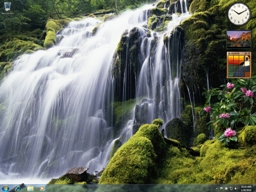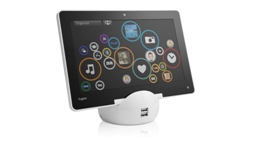
Con il comunicato stampa di seguito allegato, Microsoft, mediante la dichiarazione di uno dei suoi VP, Steve Guggenheimer, ha confidato che, a seguito del feedback positivo ricevuto con le Release Candidate, le Release to Manufacturing (RTM) dei nuovi Sistemi Operativi Windows 7 e Windows Server 2008 R2 saranno consegnate ai partner durante la seconda metà del prossimo mese di Luglio.
Con una simile tempistica per le RTM, il gigante statunitense ha già fissato le date di lancio dei suoi due nuovi prodotti: sia Windows 7 che Windows Server 2008 R2 saranno infatti disponibili sul mercato internazionale a partire dal giorno 22 Ottobre 2009, e dunque con ampio anticipo rispetto al periodo natalizio: ciò darà modo agli OEM e ai system builder di adeguare i propri prodotti in funzione dei nuovi OS, Windows 7 in primis.

[Immagine ad alta risoluzione]

[Immagine ad alta risoluzione]

TAIPEI, Taiwan - June 3, 2009 - Today during a keynote address at Computex 2009 in Taipei, Microsoft’s OEM Division Corporate Vice President Steve Guggenheimer revealed that the company is confident with the progress made with Windows 7 and Windows Server 2008 R2, and that as a result, Microsoft will deliver Release to Manufacturing (RTM) code to partners in the second half of July. Windows 7 will become generally available on Oct. 22, 2009, and Windows Server 2008 R2 will be broadly available at the same time.
"As we’ve said many times, quality is our primary goal," Guggenheimer said. "We announce each milestone once we’re confident of where we are in the development cycle and that it is ready to be shared with customers and partners. We’ve received great feedback from our partners who are looking forward to offering Windows 7 to their customers in time for the holidays."
In addition to this, Guggenheimer announced that Microsoft will make available an upgrade option, so partners can offer customers the ability to purchase a Windows Vista-based PC and install Windows 7 when it’s ready.
"Microsoft has been working closely with partners to help our mutual customers be able to enjoy the many benefits of Windows 7," he said. "With that in mind, we’re excited to say that there will be a Windows upgrade program available. Consumers can buy that new PC, whether for a student heading off to college or just because they need a new one, and know they’ll get Windows 7 as part of the deal."
The actual start date for the program will be announced when it is ready for consumers, and partners are ready to provide details to customers.
Today’s keynote address is Guggenheimer’s second at Computex. The last time he spoke at the show, he had just taken over the helm of OEM, the division that works with hardware manufacturers worldwide to integrate Microsoft technologies and bring PCs, laptops, mobile handsets and other devices to life.
Although the economic realities of the past year have created new challenges for customers, partners and the IT industry, Guggenheimer says the power of innovation, through both software and broad collaboration with partners, will continue to benefit consumers, the industry and the economy at large.
"What we’re doing with Windows will continue to improve people’s lives so that that technology enables them to communicate better, make tasks simpler and new things possible," he says. "Our partners in the hardware space, our competitors in software — the entire industry is doing incredible things."
Casting a Wider Net
To illustrate the point, Guggenheimer points to the evolution of small notebook PCs (often referred to as netbook PCs), the ensuing emergence of a new class of "consumer Internet devices," and Microsoft’s collaboration with "smart" appliance maker Fugoo LLC, which was first announced at CES in January.
The broad adoption, Guggenheimer says, shows that small notebooks are answering a market need, especially given the economic situation. It also reflects that they have evolved a great deal in a short time to become powerful personal computers as opposed to the basic Web-surfing tools they were initially.
"A year ago when these smaller PCs first came onto the scene, many in the space were saying consumers wouldn’t want or need these devices to be full-featured," he says. "In fact, the exact opposite turned out to be true. Consumers really do want small notebook PCs to work like their laptops and desktops. Windows provides a familiar and easy-to-use experience that consumers want and demand from these devices."
Asked why consumers are choosing smaller PCs with Windows, Guggenheimer says, "Because Windows makes life simple. It’s easier to use, just works out of the box with people’s stuff, and ultimately offers more choice. Over the last 34 years, we’ve learned a lot about what people want from their PCs, and we’ve worked with OEMs to provide an experience that meets those needs."
Guggenheimer says the economy may also be facilitating growth in the small notebook PC space. Buyers are becoming increasingly cost-conscious and mobile, and laptop sales are soon expected to outstrip desktop PC sales in developed economies.
"Fortunately, the breadth of the Windows platform gives device manufacturers a host of options when it comes to designing new devices to suit new forms of consumer demand," he says.
Already, several OEMs have announced plans to issue new small notebook PCs designed for the Windows 7 operating system.
"They are finding that even on the scaled-down hardware of the small notebook PC platform, Windows is running smoothly and delivering the experience consumers are asking for because it just makes things simpler and tasks easier," says Guggenheimer.
Devices Building New Market Segments
An example of new devices is in the broadening class of consumer Internet devices, which fall somewhere between smartphones and the full-featured small notebook PCs running Windows today.
"This next generation of smart, connected, service-oriented devices will give people mobile access to a rich set of media and information," he says. "Using Microsoft technologies like Windows Embedded CE, Visual Studio, Silverlight and Expression Blend, we can enable devices such as personal navigation devices, portable media players, set-top boxes and networked TVs to provide a rich browsing experience and a dynamic, immersive user interface."
Guggenheimer says the first such devices will connect to what Microsoft calls consumers’ "digital lifestyles," such as files, pictures, music and video, that are currently stored primarily on Windows-based PCs.
"Soon these devices will become even more connected, working not only with PCs but also with cloud services from third parties and Microsoft, such as Windows Live Services," he says.
At Computex this week, Kevin Dallas, general manager of the Windows Embedded Business, will showcase the potential of consumer Internet devices with a demonstration based on NVIDIA Tegra computer-on-a-chip technology, which works with the Windows Embedded CE platform for specialized, small-footprint devices.
Another bid to create a useful class of consumer devices is Fugoo. The Fugoo platform uses a version of Windows in conjunction with widely available Web "widgets," which publish everything from the time and weather to currency exchange rates and horoscopes.
Fugoo’s prototype devices integrate that software functionality into home appliances to create dynamic displays in clocks, picture frames and even coffee makers.
At Computex, Fugoo is announcing that its first commercially available product, a digital picture frame launched in partnership with Pandigital in the U.S., will be available on the market this summer.
The frame is Web-enabled and can download photos from social networks or online photo services. It also allows users to download photos directly from a PC or digital camera.
Broad Partner Opportunity on Windows Platform
Whatever PC device consumers and businesses choose to use, ultimately, Guggenheimer says, Windows will support the entire spectrum of devices easily.
"With the release of Windows Server 2008 R2, companies of all sizes will get big improvements in virtualization, Web and management," he says. "These areas, along with several features that improve scalability and reliability, help deliver a strong value proposition on the server side to complement Windows 7."
To address OEMs’ request for a server product suited for smaller businesses, Guggenheimer points to the recent release of Windows Server 2008 Foundation. This will be offered pre-installed on hardware products from Acer Inc., Dell, Fujitsu Technology Solutions, HP, Lenovo, IBM Corp. and NEC Corp. later this year, and will be available initially in 40 countries and several languages.
"We expect this new server platform to be popular in markets across the globe, with its modest cost making it possible for small companies to grow, innovate and stay competitive, which in turn can ignite growth for their local economies," he says.
OEMs will get another big boost with the Windows 7 Device Stage feature, which is expected to prove especially useful as more and more consumers hope to connect and use multifunction devices such as printers, cameras and cell phones with their PCs.
"Microsoft has been working to enable Windows to work well with all these devices for some time, and we think partners are ready and excited to deliver," Guggenheimer says. "Ultimately our greatest strength here, both for us and our partners, is the depth and breadth of the Windows ecosystem — a universe that took more than three decades to build."
News Source: Microsoft Press Release
Links
|